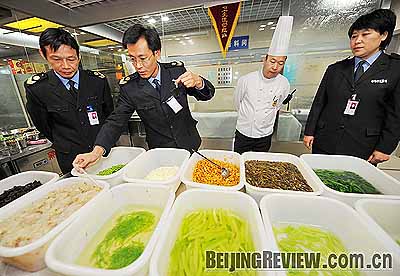|
Food additives are usually regarded as the culprit of some notorious food safety incidents in China, such as the melamine tainted milk powder and food poisoning caused by Sudan pigment, a synthetic chemical. Such scandals have led people to associate additives with poison, and make them reluctant to use additives.
 |
|
FOOD FOR THOUGHT: Hygiene inspectors in Yinchuan City, Ningxia Hui Autonomous Region, examine the use of food additives, on December 31, 2008 (WANG PENG) | There is widespread misunderstanding about food additives across China, according to Wang Zhutian, Deputy Director of the Institute of Nutrition and Food Safety, Chinese Center for Disease Control and Prevention. He stressed that melamine and Sudan pigment are not food additives at all, and are explicitly forbidden for use in food.
"In fact, we need food additives," Wang said. "Without food additives, we will not have cookies or instant noodles; without food pigment, the color of many food products will be very dull. For instance, we will not have colorful candies."
"Food additives are omnipresent in our diet," said Ji Heli, a professor in the School of Perfume and Aroma Technology, Shanghai Institute of Technology. He took bread as an example. According to Ji, scores of food additives are usually added to make bread. "An average person eats at least 80 to 90 types of food additives every day," he explained.
Growing awareness
Food additives were first used in foods consumed by the Chinese public in the early 1980s, according to Xu Jiachao, a professor in the College of Food Science and Engineering, Ocean University of China. The food additives used in China early on were primarily preservatives and moisturizers. They were initially used to change the flavor and color of foods. Later, additives such as vitamin C, trace minerals and amino acid were used to enhance nutrition and health value. These food additives are safe.
The public is growing more aware of food safety over time, Wang said, and it is a good thing that people are more concerned with the effect of food additives on their health. In the beginning, they were concerned about food containing traditional pollutants such as pesticides or heavy metals, then they worried about biological pollution sources, and now many people are concerned with the safety of food additives, he said.
"Food additives enrich the variety of foods. Without food additives, we would not have so many types of foods with great tastes and colors, which can meet the needs of even picky customers," said Du Huizhen, Deputy Director of Shandong Nutrition Society.
"Developed countries have higher living standards, more advanced food industries, and many more varieties of food additives are used," said Qi Qingzhong, Secretary General of China Food Additives and Ingredients Association. "Food additives that meet the national standard are safe, so consumers do not need to worry about their safety. In fact, some food additives make foods safer." Qi added.
Qi's opinion was echoed by Wang Dongfeng, Associate Dean of the College of Food Science and Engineering, Ocean University of China.
Wang explained that the illegal use of some industrial chemicals such as formaldehyde or rongalit in foods has created a panic and ruined the reputation of additives.
There are about 2,000 food additives authorized by the Ministry of Health in China, and over 1,000 of these additives are aromas, according to Wang Zhutian of the Chinese Center for Disease Control and Prevention. Aroma is not regulated as a food additive in many countries. The number of additives authorized in China is relatively small compared with other countries. For instance, the United States has over 4,000 authorized food additives, and Japan also has more authorized food additives than China.
As the food industry grows rapidly, there is a huge market for food additives. Statistics on the website of the Ministry of Health show that in 2007, China produced a total of 5.24 million tons of food additives, bringing in sales revenue of 52.9 billion yuan ($7.75 billion). Food additives have become a major part of the food industry.
Food additive standards
The diet of Chinese people differs from that of Western nations. For instance, people in China eat more vegetables. Because of this, food additive standards also differ across countries. Wang raised the example of benzoyl peroxide, a chemical used to whiten flour. In China, 0.06 gram of this chemical is allowed in 1 kg of flour, while 0.15 gram is acceptable in Canada, and the United States does not restrict its use at all. Even though food additives are safe, the convention followed in China is to use as little of them as possible.
Although China does not have as many types of additives as many
|
